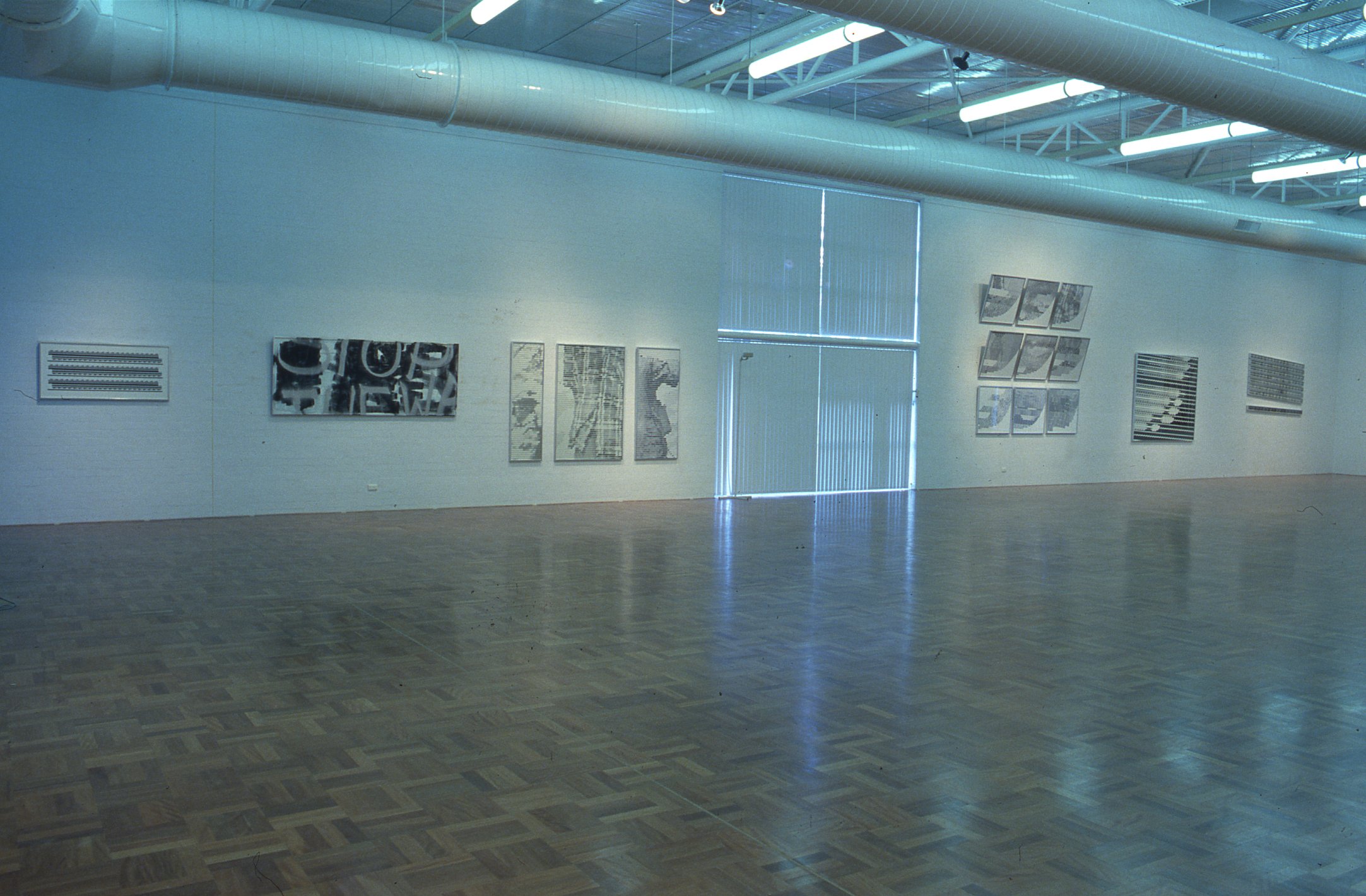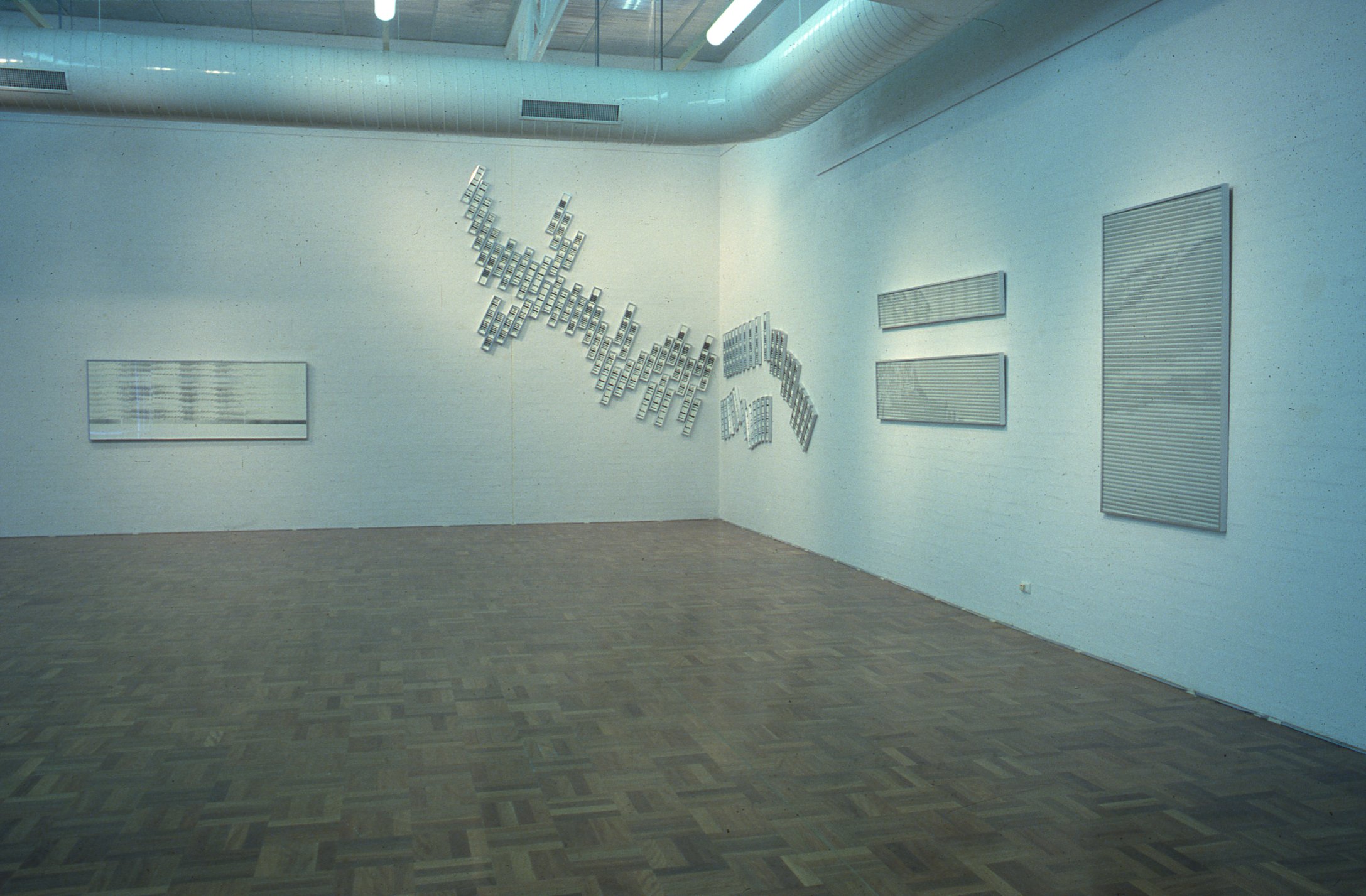From the Armchair: An Essay in Medium Detail
This page is under construction. More content to be added.
Invitation. John Reid’s ANU Creative Arts Fellowship exhibition. 1981.
Udo Selbach Gallery, Canberra School of Art. John Reid’s ANU Creative Arts Fellowship exhibition. 1981. North wall.
From left to right: Work 6 Televised Form #1; Work 21 Dissent; Work 11 News Item #1; Work 12 News Item #2; Work 13 News Item #3; Work 14 News Item #4 (Nine panels); Work 18 Detail of James Dibble’s Glasses; Work 7 Televised Form #2.
Udo Selbach Gallery, Canberra School of Art. John Reid’s ANU Creative Arts Fellowship exhibition. 1981. North and East walls.
From left to right: Work 14 News Item #4 (Nine panels); Work 18 Detail of James Dibble’s Glasses; Work 7 Televised Form #2 (Nine panels); Work 8 Televised Form #3 (Four panels).
Udo Selbach Gallery, Canberra School of Art. John Reid’s ANU Creative Arts Fellowship exhibition. 1981. East and South walls.
From left to right: Work 9 Televised Form #4 (Two panels); Work 1 Conversion for Black and White Transmission #1 (Two panels); Work 2 Conversion for Black and White Transmission #2 (Six panels); Work 3 Conversion for Black and White Transmission #3; Work 4 Conversion for Black and White Transmission #4 (Four panels); Work 20 Prize (Twenty three panels); Work 5 Conversion for Black and White Transmission #5 (Three panels); Work 22 End of Transmission (Two panels).
Udo Selbach Gallery, Canberra School of Art. John Reid’s ANU Creative Arts Fellowship exhibition. 1981. South and West walls.
From left to right: Work 15 News Item #5; Work 10 Televised Form #5 (78 panels); Work 19 Detail of James Dibble’s Forehead (Top); Work 16 News Item #6 (Bottom); Work 17 News Item #7.
Gallery Guide to artworks
John Reid and Colin Plowman, The Australian National University’s Assistant Vice-Chancellor, (right), who opened the exhibition, From the Armchair An Essay in Medium Detail. Photographer: Unknown
Left to right: Work 11 News Item #1. 157.5 x 46.0 x 4.0 cm Silkscreen on paper. Work 12 News Item #2. 157.5 x 104.0 x 4.0 cm Photographic paper. Work 13 News Item #3. 157.5 x 70.0 x 4.0 cm Silkscreen on card. 1981. [Later, these three works were regarded as one work under the title, News Item, 1981. The three panels are in the ANU Art Collection as on e work. Accession #1269]
‘News Item’ is the key artwork of the body of work produced on my ANU Creative Arts Fellowship, 1977-79. The Fellowship work was exhibited under the title, ‘From the Armchair An Essay in Medium Detail’, Udo Selbach Gallery (Canberra School of Art Gallery), 12 June – 3 July, 1981. It was the first one-person show in the Canberra School of Art Gallery.
The Fellowship was awarded for one year but was extended so that I could continue to use the studio that I was allocated in Childers Street. I shared a block there with the two other 1977 Fellows, ceramicist, Tim Moorehead, and painter, Dusan Marek. I joined the staff at the Canberra School of Art in 1978 and continued to work on my Fellowship project in the Childers Street studio until the end of 1979.
Of the three panels, Work 12 was completed first. It was exhibited in 1979 on two occasions, both under the title, ‘Detail of Televised Shirt’. One showing was the ‘Canberra School of Art Staff Exhibition’, Solander Gallery, Yarralumla, and the other was in an exhibition curated by Sasha Grishin, ‘A.N.U. Creative Arts Fellows 1964-79’, Melville Hall, ANU. Works 11 and 13 were subsequently added for the culminating show in 1981.
Depicted in the works are three items of clothing: Work 11 - a camouflage jacket of a South Vietnamese soldier (one colour, silkscreen, paper – nefarious); Work 13 - battle fatigues of Brig. Gen. Nguyen Ngoc Loan, chief of the South Vietnamese national police (two colour, silkscreen, card – bold, assertive); and Work 12 - a flannelette shirt of Viet Cong prisoner, Nguyen Van Lem (B&W photographic paper – delicate, absorptive, resilient). The soldier, the police chief and the prisoner are central figures in Eddie Adam’s still photograph and Neil Davis’s video coverage of the summary execution that took place in a Saigon Street during the Tet Offensive, Vietnam War, in 1968. Upon publication and broadcast, these mass media images transmitted the horror of war (yet again) throughout the western world.
Eddie Adams’s video was broadcast on the ABC national television news – the first time an actual execution was aired on Australian television and at once became a shocking, horrific and unforgettable experience for those who saw it. (I could not ascertain if it was James Dibble or Ross Symonds who read the news that evening, neither of them could remember – I took a punt on James Dibble – hence details of his distinctive glasses featuring in the show). I wanted the subject matter of Works 11, 12, 13, and indeed of the whole exhibition, to refer (subtly/suggestively/subliminally) to the act of watching television. I needed familiar and unforgettable content as reference.
Although it had a different emphasis at the beginning, my Creative Arts Fellowship project settled into a static, graphic, analysis of the formal visual qualities of the electronic, dynamic television image – specifically black and white televised imagery that was prevalent in Australia in the late nineteen sixties when photographic media made further significant contributions to public perceptions of war. (The first was possibly Roger Fenton’s coverage of the Crimean War in mid-eighteen hundreds followed by Mathew Brady et al and their coverage of the American Civil War). I was interested in the nature of the signal that carried the social/emotional impact.
A significant component of the research lay in perfecting the component strips of paper – nine tonal values from 10% to 90% black/white and the 72 connecting elements that would allow an aesthetically satisfactory transition from a strip of one tonal value to another. The original artwork was done in pen and ink and photographically reproduced and assembled into a final ‘television screen alphabet’. These ‘characters’ were then reproduced in number either photographically again, or by silkscreen, to assemble into an optically active TV-like image when viewed from a distance. At close inspection, the image made no interpretative sense but appeared simply as stark, regimented, hard-edged marks representing graphically the effect of electron gun as it sweeps 312.5 slightly diagonal lines across the television tube before returning for another sweep to complete a 625-line scintillation
[Research at the time in other disciplines revealed that the optical qualities of the black and white television image, flickering at a rate that caused the eye to struggle to catch each flicker before it changed – a 312.5-line sweep, cause eye fatigue and acerbated aggressive behaviour especially in children. These were fascinating conclusions that seemed to complement my graphic investigation and further nuisance the narrative about the connection between medium and social impact].
My understanding was that the Creative Arts Fellowship awarded in 1977 constituted a deliberate departure from previous Fellowships being awarded to a single, well established high profile recipient. Three were awarded: Dusan Marek, arguably one of the best surrealist painters working in Australia; Tim Moorehead, a mid-career ceramicist; and myself as an emerging graphic artist. The Fellowship played a seminal role in my professional life as a visual artist. For me it enabled the transition from a graphic design practice (resolving visual communication issues for third parties) into a fine art one (resolving my own visual communication issues through engaging in creative research and intellectual discourse). The Creative Arts Fellowship facilitated my entry into the Canberra School of Art and opened thirty + years of academic life in the visual arts.







